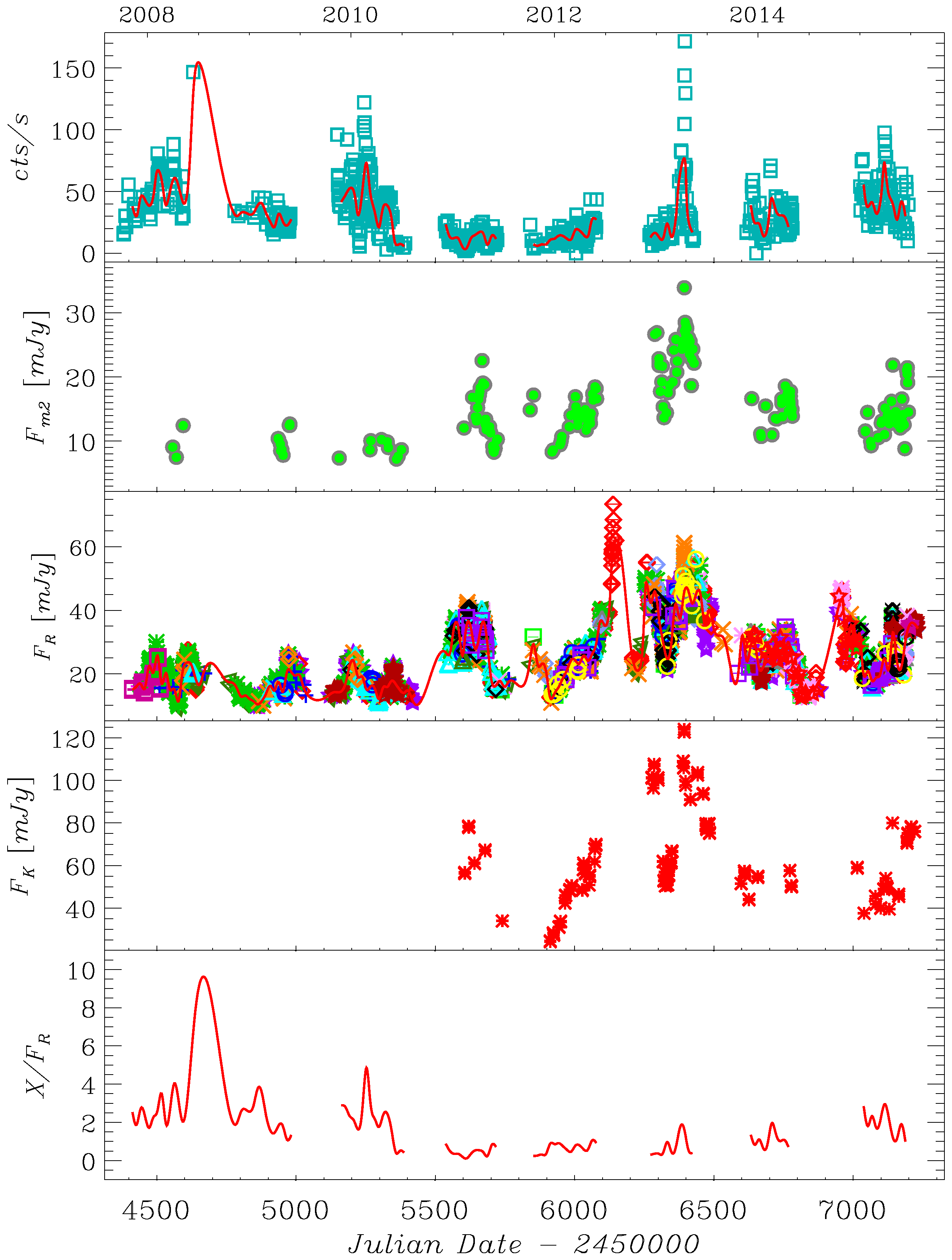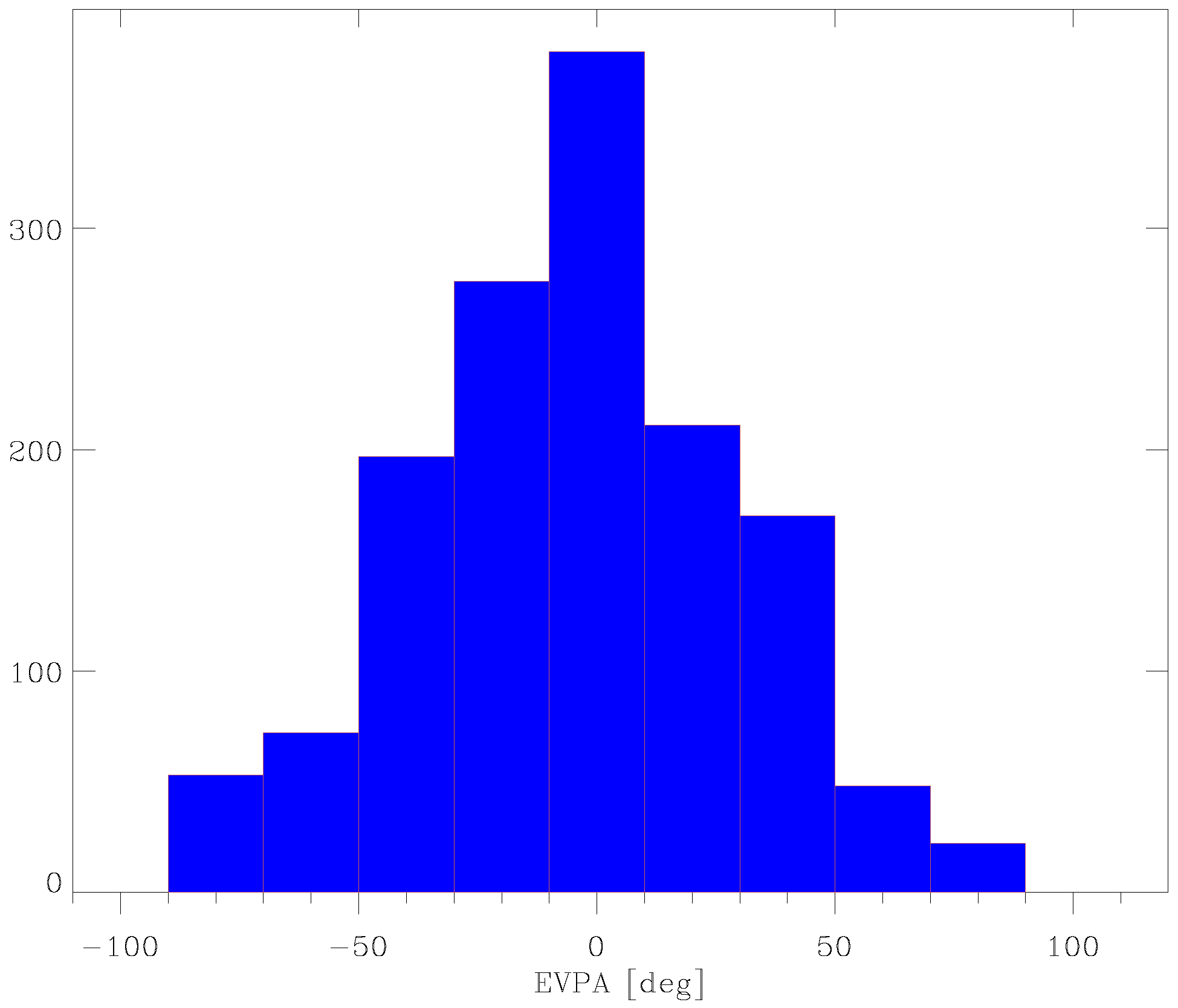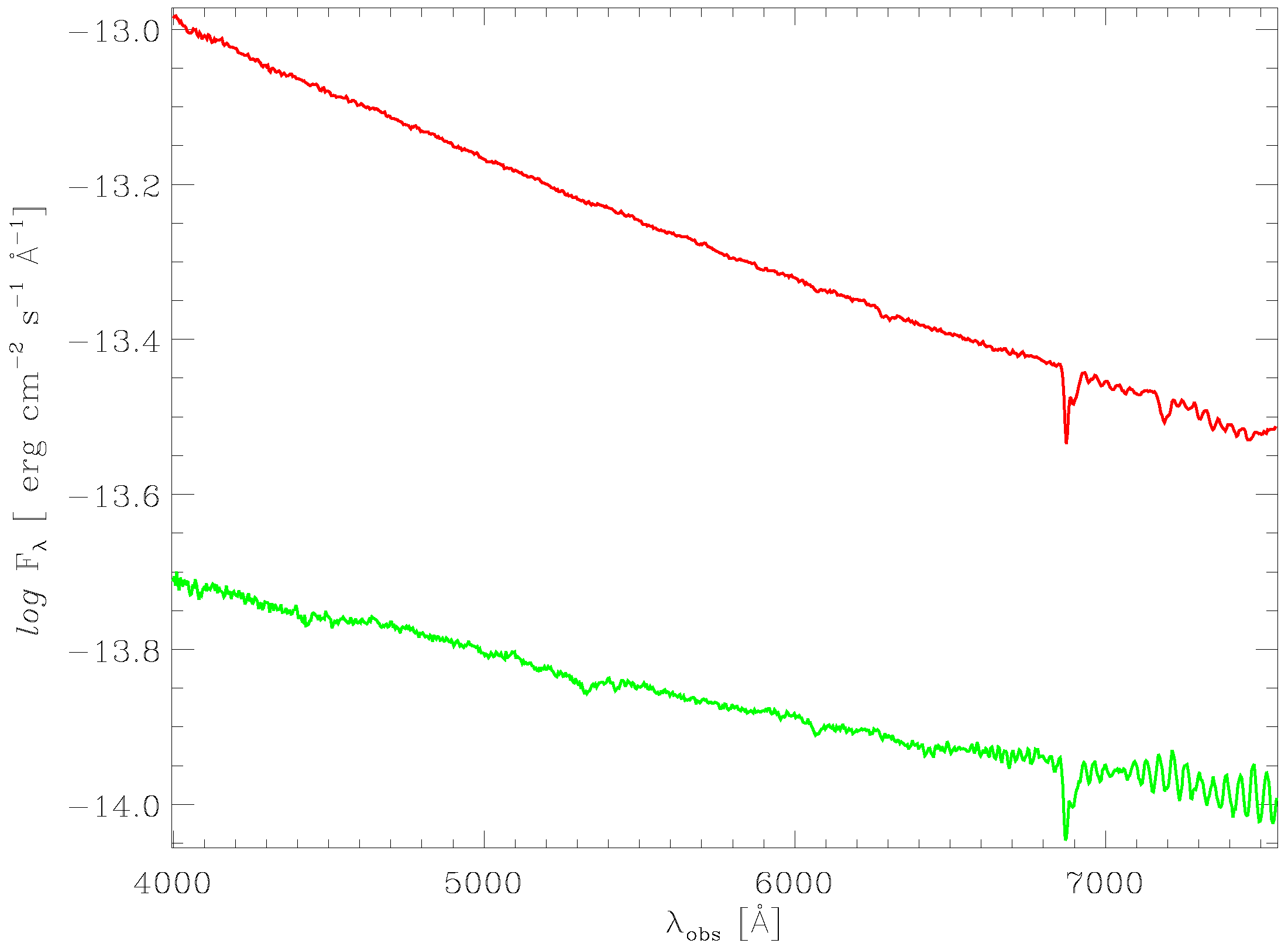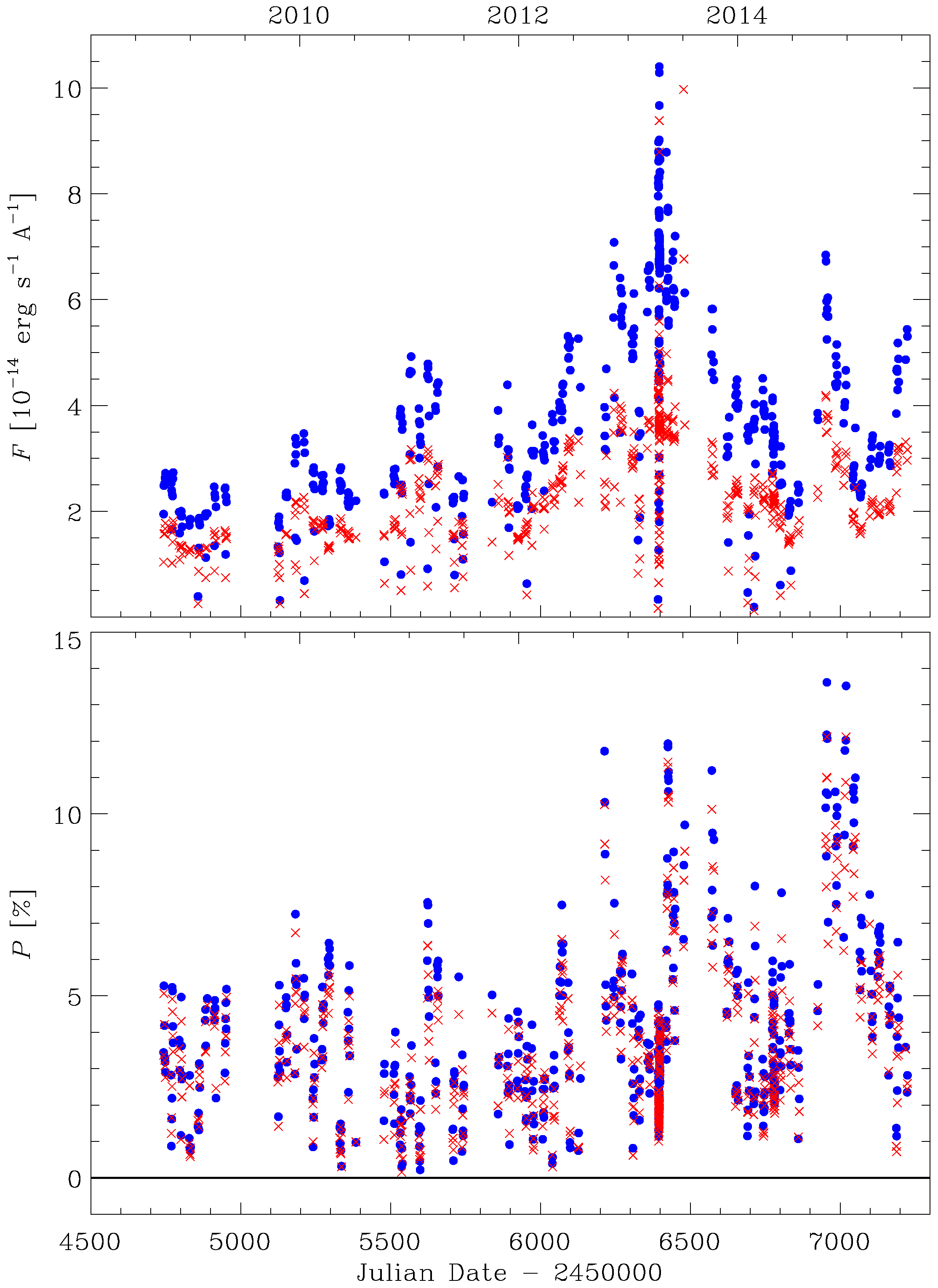Investigating the Puzzling Synchrotron Behaviour of Mrk 421
Abstract
:1. Introduction
2. The GASP-WEBT Collaboration
3. Multiwavelength Light Curves of Mrk 421
4. Long-Term Optical Polarization Variability
5. Optical Spectropolarimetric Variability
6. Conclusions
Author Contributions
Conflicts of Interest
References
- Ulrich, M.-H.; Kinman, T.D.; Lynds, C.R.; Rieke, G.H.; Ekers, R.D. Nonthermal continuum radiation in three elliptical galaxies. Astrophys. J. 1975, 198, 261–266. [Google Scholar] [CrossRef]
- Punch, M.; Akerlof, C.W.; Cawley, M.F.; Chantell, M.; Fegan, D.J.; Fennell, S.; Gaidos, J.A.; Hagan, J.; Hillas, A.M.; Jiang, Y.; et al. Detection of TeV photons from the active galaxy Markarian 421. Nature 1992, 358, 477–478. [Google Scholar] [CrossRef]
- Carnerero, M.I.; Raiteri, C.M.; Villata, M.; Acosta-Pulido, J.A.; D’Ammando, F.; Smith, P.S.; Larionov, V.S.; Agudo, I.; Arévalo, M.J.; Arkharov, A.A.; et al. Multiwavelength behaviour of the blazar OJ 248 from radio to β-rays. Mon. Not. R. Astron. Soc. 2015, 450, 2677–2691. [Google Scholar] [CrossRef]
- Larionov, V.M.; Villata, M.; Raiteri, C.M.; Jorstad, S.G.; Marscher, A.P.; Agudo, I.; Smith, P.S.; Acosta-Pulido, J.A.; Arévalo, M.J.; Arkharov, A.A.; et al. Exceptional outburst of the blazar CTA 102 in 2012: the GASP–WEBT campaign and its extension. Mon. Not. R. Astron. Soc. 2016, 461, 3047–3056. [Google Scholar] [CrossRef]
- Raiteri, C.M.; Villata, M.; Smith, P.S.; Larionov, V.M.; Acosta-Pulido, J.A.; Aller, M.F.; D’Ammando, F.; Gurwell, M.A.; Jorstad, S.G.; Joshi, M.; et al. Variability of the blazar 4C 38.41 (B3 1633+382) from GHz frequencies to GeV energies. Astron. Astrophys. 2012, 545, A48. [Google Scholar] [CrossRef]
- Raiteri, C.M.; Villata, M.; D’Ammando, F.; Larionov, V.M.; Gurwell, M.A.; Mirzaqulov, D.O.; Smith, P.S.; Acosta-Pulido, J.A.; Agudo, I.; Arévalo, M.J.; et al. The awakening of BL Lacertae: observations by Fermi, Swift and the GASP-WEBT. Mon. Not. R. Astron. Soc. 2013. [Google Scholar] [CrossRef]
- Smith, A.G. Blazar Continuum Variability; Miller, H.R., Webb, J.R., Noble, J.C., Eds.; Astronomical Society of the Pacific Conference Series: San Francisco, CA, USA, 1996; Volume 110, p. 3. [Google Scholar]
- Jorstad, S.G.; Marscher, A.P.; Larionov, V.M.; Agudo, I.; Smith, P.S.; Gurwell, M.; Lähteenmäki, A.; Tornikoski, M.; Markowitz, A.; Arkharov, A.A.; et al. Flaring behavior of the Quasar 3C 454.3 across the electromagnetic spectrum. Astrophys. J. 2010, 715, 362. [Google Scholar] [CrossRef]
- Larionov, V.M.; Jorstad, S.G.; Marscher, A.P.; Raiteri, C.M.; Villata, M.; Agudo, I.; Aller, M.F.; Arkharov, A.A.; Asfandiyarov, I.M.; Bach, U.; et al. Results of WEBT, VLBA and RXTE Monitoring of 3C 279 during 2006–2007. Astron. Astrophys. 2008, 492, 389–400. [Google Scholar] [CrossRef]
- Smith, P.S.; Schmidt, G.D.; Hines, D.C.; Foltz, C.B. Optical Spectropolarimetry of Quasi-stellar Objects Discovered by the Two-Micron All Sky SurveyA portion of the results presented here made use of the Multiple Mirror Telescope Observatory, a facility operated jointly by the University of Arizona and the Smithsonian Institution. Astrophys. J. 2003, 593, 676. [Google Scholar]
- Nalewajko, K. Polarization swings from curved trajectories of the emitting regions. Int. J. Mod. Phys. D 2010, 19, 701–703. [Google Scholar] [CrossRef]
- Marscher, A.P. Turbulent, extreme multi-zone model for simulating flux and polarization variability in blazars. Astrophys. J. 2014, 780, 87. [Google Scholar] [CrossRef]






© 2016 by the authors; licensee MDPI, Basel, Switzerland. This article is an open access article distributed under the terms and conditions of the Creative Commons Attribution (CC-BY) license (http://creativecommons.org/licenses/by/4.0/).
Share and Cite
Carnerero, M.I.; Raiteri, C.M.; Villata, M.; Acosta Pulido, J.A.; Smith, P.S.; Larionov, V.M.; The WEBT Collaboration. Investigating the Puzzling Synchrotron Behaviour of Mrk 421. Galaxies 2016, 4, 61. https://doi.org/10.3390/galaxies4040061
Carnerero MI, Raiteri CM, Villata M, Acosta Pulido JA, Smith PS, Larionov VM, The WEBT Collaboration. Investigating the Puzzling Synchrotron Behaviour of Mrk 421. Galaxies. 2016; 4(4):61. https://doi.org/10.3390/galaxies4040061
Chicago/Turabian StyleCarnerero, Maria I., Claudia M. Raiteri, Massimo Villata, Jose A. Acosta Pulido, Paul S. Smith, Valeri M. Larionov, and The WEBT Collaboration. 2016. "Investigating the Puzzling Synchrotron Behaviour of Mrk 421" Galaxies 4, no. 4: 61. https://doi.org/10.3390/galaxies4040061




